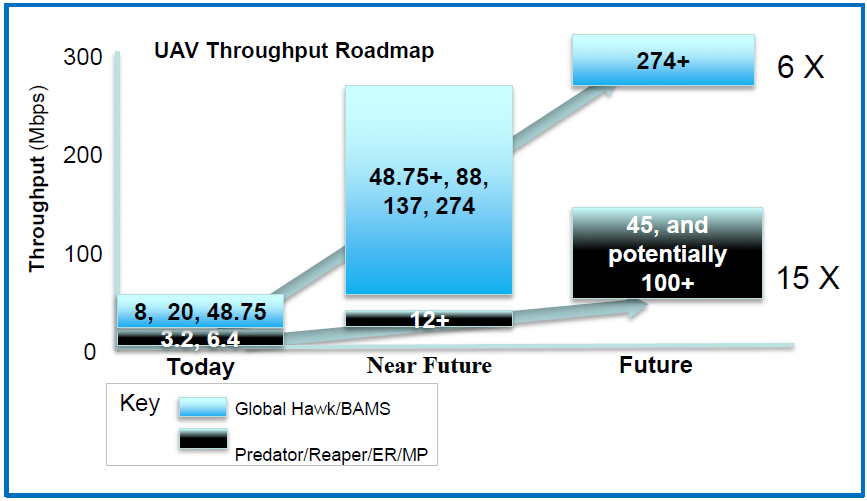Why Ku-band Makes the Most Sense for the DoD
Commercial satellite capacity has proven its reliability over the last decade of U.S. military operations in the Middle East, Southwest Asia and Africa, and is increasingly being considered as a centerpiece of the Pentagon’s future strategy. The U.S. Department of Defense (DoD) is now considering the best approach for the future to ensure that it can meet increasingly varied and ever-evolving satellite communications needs across the global geo-political landscape.
The DoD faces two issues: First, how to leverage its existing investments in both commercial and government-owned ground and spacecraft infrastructure, given that the current constrained budgetary climate of the federal government is likely to be a mainstay; and second, how to meet the warfighter’s need for increasingly higher connectivity while also providing enhanced features such as flexibility, portability, connectivity, and information assurance.
The answer lies in the Ku-band, that portion of the satellite spectrum that has the most diverse usage across land, air and sea-based applications. The Ku-band is:
- The most versatile for DoD combat commands, services and agencies across land, air and sea.
- Suited for large ground satellite dishes, small aircraft antennas, and every size in between.
- Proven to work well when other bandwidths succumb to rain-fade.
- Has the largest deployed terminal infrastructure and usage within the DoD. (7134 MHz at Ku in 2010, last publicly released figures by DISA – more than 10 times usage in each of the other bands (C, X, Ka)
- Has the largest commercial satellite fleet-availability world-wide across all satellite operators, maximizing the likelihood that portability and surge requirements can be met when needed.
Commercial satellite capacity using the Ka-band is beginning to come online around the world, but making use of that capacity would require the DoD to make substantial capital expenditures to upgrade terminals on aircraft, ships and ground stations. This is not a fiscally responsible approach, especially when higher-performance can be extracted from existing terminals. Leveraging the existing terminal-base, as is or through software upgrades, is what makes the most sense.
The DoD is gradually making the transition from fewer boots-on-the-ground to more eyes-in-the-sky, and the Ku-band is already in wide use for unmanned aerial vehicles (UAVs) used for intelligence, surveillance and reconnaissance (ISR). DoD-outlined objective data rates can be easily attained using existing Ku-band terminals on Predator/Reapers and Global Hawks, as can be seen in the figure below.
With Epic, Intelsat’s next-generation constellation of high-throughput satellites, the DoD can deliver high data-rate connectivity through its large installed base of Ku-terminals across all applications, without sacrificing user control of service elements. Each EpicNG satellite is expected to have a bandwidth equivalent that is 5 to 8 times a conventional satellite, and 2 to 3 times the capacity of each of the WGS satellites operated by the Air Force. EpicNG delivers the best value to the DoD by delivering on:
Performance
- Provides dramatic terminal throughput enhancement from increased link efficiencies (Mbps/MHz).
- Supports migration from mobile satellite services (MSS) to broadband fixed satellite services (FSS).
- Compatible with a range of multi-media, on-the-move applications.
- Addresses current and expected areas of operations and surge.
Flexibility
- Compatible with customer-defined network concept of operations.
- Supports broadcast or multicast imagery dissemination.
- Offers full data-path agility with the IntelsatOne ground network or with customer sanctuary gateways.
- Delivers guaranteed access to capacity for mission-critical applications.
Security
- Compliant with information assurance standards for resilience.
- Provides enhanced quality-assurance surveillance capabilities.
Staying with the Ku-band keeps the DoD’s largest existing terminal infrastructure investment both relevant and future-proof. Continuing to use the Ku-band focuses the DoD’s resources on getting more out of systems that are already in-place and are battle-proven. Finally, using the Ku-band allows the DoD to tap into the most widely deployed satellite band and to take advantage of its inherent, large-scale market economics. In short, the Ku-band – the DoD’s current satellite communications band of choice – has served the government well and is poised to deliver the future.






















